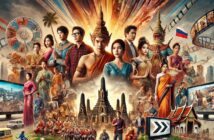The session’s speakers: Kristina Hollstein, director acquisition and coproductions, documentaries, ZDF Enterprises Germany; Catherine Alvaresse, deputy director of knowledge and discovery, factual programming unit, ARTE France; Lee Eartlett, EVP Discovery Communications, President Discovery Studios USA; Hiromichi Iwasaki, executive producer, NHK Japan; moderated by Pat Ferns, pres+executive producer, Ferns Productions Canada.
Moderator Pat Ferns called « Giant Squid: The Monster is Real » the « story about scientific, technological, creative and financial challenges, » but it was also a story about partnership. « Often in coproduction, sticking with your copartners is what matters, » said Ferns.
Alvaresse of ARTE called coproduction a question of trust. « For me NHK is a lifelong partner, so there’s a lot of trust there. »
Eartlett of Discovery, which worked closest with NHK, said it isn’t often that the network does outside coproductions. « Discovery will create a US-based programme, then our international channels will decide whether to join us. But most coproductions of interest to me are external. »
Iwasaki, who led the game, simply said coproduction is « necessary for us. For this giant squid project, we couldn’t advance without coproducers. »
It helps to consider the technology involved. NHK required investment in a vessel, experienced crew, a steel camera that could be dropped 1,000 feet undersea, and the development of a red light invisible to giant squid.
One of the major mitigating factors for finding coproducers was the topic’s mythological element. Said Alvaresse, « It’s a big myth, very Jules Verne, so we had to go there. » Hollstein agreed: « There’s the mystery: for many it’s a big fairy tale. »
Eartlett of Discovery, the first and fastest coproduction « yes » NHK got, said, « The chances of finding it on a scale of 1-10 were -3. But what the hell: the possibility of putting something out there that people hadn’t seen before is the sweet spot. One of our mottos is ‘satisfy curiosity’. »
« Giant squid are there, in Japanese water, » said Iwasaki. « NHK began giant squid research over 10 years ago. »
In collaboration with a scientist, in 2004 NHK enjoyed its first success at nabbing footage: they lowered a steel camera that recuperated 500 images of a living giant squid. In 2006, they filmed moving images and made a 2-hour special, generating lots of response.
« NHK realised how much impact giant squid programmes have. Since then we’ve pitched a special programme for giant squid using submersibles, but it was always rejected because it costs a lot and there’s no guarantee for a film. »
In 2010 he had a last chance to convince the NHK’s controller. The day before the pitch, he had a conference call with Discovery’s Clark Bunting, who said yes so quickly it made everyone’s head spin. The inevitable result of this was the Squid Summit in Washington, a chance for Discovery and NHK’s folks to meet.
« Something we discovered over the years for coproduction is, the level of trust has to be extremely high, » said Eartlett. « Once you have to go back to the contract, you know you have a problem. So seeing ‘the whites of their eyes’ is very important. »
We were then treated to a trailer for « Monster Squid ». According to the narrator, « We now know they are indeed huge, and they grapple with whales. But they’re still one of earth’s last big enigmas. » This footage represents « the very first time [humans]saw the giant squid … alive. »
The coproduction’s format was unique. NHK produced its own documentary, and Discovery made a separate American version « tailored to the market: a difference in host, presenters, pacing and treatment of subject matter, » according to Eartlett, who added, « We had every single piece of footage that NHK had shot and vice versa. »
« Discovery’s story is according to their expeditions. Our story starts 10 years ago. We combined all our discoveries in one programme, » said Iwasaki.
ARTE and ZDF, whose coproduction participation was lighter, shared a version for their markets. Eartlett suggested they take the NHK version as he felt it would be better for international sales.
« This was probably the best coproduction experience I’ve had, » said Eartlett. « I’d be surprised if it could be replicated again. The idea of dual crews, 100% sharing and cooperation, is something that will stick in my mind for future coproductions. »
Hollstein built on that sentiment. « I’m afraid we won’t have this experience and challenge again because it was just unique. Working with NHK Japan was a great experience; no email went unanswered, there was no question for material. We were always under the impression that NHK tried finding solutions very quickly. »
« It was a real success, » Alvaresse agreed. « It was our best marketshare for primetime Sunday night [in France and Germany]. It was also the best for catch-up TV. It showed us that with good partners, everything is possible. But it was also a great collaboration because the topic was absolutely amazing. »




